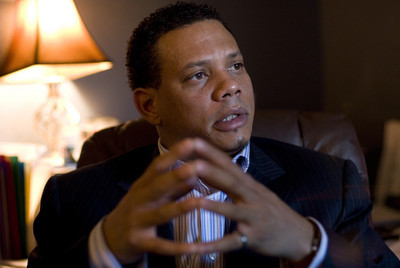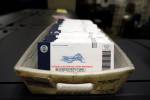Coloring between the lines
"U.S. Decisively Elects First Black President," read the Nov. 5 Washington Post headline. Decisive as Barack Obama's election was, however, his blackness is not. The former senator from Illinois is equally white. (His mother is Caucasian, his father African.)
Pressure exists in this country to shoehorn citizens into racial boxes, and "multiracial" has not been one of the boxes.
"For some people, it's based on the one-drop rule," said Susan Graham, founder and executive director of Project Race, a multiracial awareness organization headquartered in Los Banos, Calif.
"It's not a law and it never has been," Graham explained. "But it's a public perception. Some people believe that one drop of blood makes you black. They look at Barack Obama and see some black, so he has to be completely black." (In a 2007 "60 Minutes" interview, Obama described himself as "rooted in the African-American community" but "not defined by it.")
Graham's group lobbied successfully for the U.S. Census to allow self-identification by more than one race. In 2000, the first year the forms were changed, 2.4 percent of Clark County residents reported belonging to multiple races. Last year, 2.8 percent did.
Although demonstrating an upswing, albeit small, both these numbers probably are underrepresented, Graham said. Just because a form allows people to classify themselves a certain way doesn't mean society allows them to. Historically, as Graham pointed out, most African-Americans come from mixed bloodlines anyway because of the system of slavery practiced in the nation's early years.
"When you first saw me, you saw a black man, correct?" asked Douglas Burnett, 36-year-old owner of a Las Vegas business consulting firm.
"And that's how I identify myself," he said. "When people look at me, what you see, touch and feel would be an African-American."
Burnett is half black, three-eighths American Indian and an eighth white.
"I've identified with those other groups as far as research -- reading about the Cherokee Indians and the French," he said. "But I don't feel it."
Some multiracial individuals respond to the societal pressure by resisting it.
"When people ask, I say that I'm biracial," said Rebecca Rogers, an assistant program director for the University of Nevada, Las Vegas.
The 32-year-old -- whose mother is white and father is black -- said blacks usually give her "a strange response."
"There are a lot of people out there who don't approve of interracial relationships," she said.
The bigotry was even stronger in Rogers' small hometown of Sparta, Ill., from which she moved in 2001.
"It was hard for me because I dealt with prejudice in my own family," she said. "My father's side would always make little comments: 'half breed,' 'mulatto' and stuff like that. But my mother's side was worse."
Rogers said her maternal grandmother wouldn't allow her to visit.
"I didn't see her house until I was 10 years old," Rogers said, noting that her grandmother eventually changed her view at that time.
Las Vegas singer Clint Holmes said he felt the stares while coming of age in the rural outskirts of Buffalo, N.Y. -- stares from people apparently trying to piece together a puzzle in their heads.
"I felt, the phrase I guess is, no place to be somebody," said Holmes, the offspring of a black jazz singer father and a Caucasian English opera singer mom. "For a long time, I thought, 'Where do I fit in this?' "
Through the years, Holmes said, his perspective changed.
"The first part of my life, I related more to the white heritage because that's what I knew," he said. "Later on, I related more to the black part of my heritage because I was in the process of learning about it."
Holmes said he now considers himself "neither and both," but added that it took a long time for him to grow comfortable in his mixed skin.
"I am a black man, because that's what society says we are," he said. "But I fully relate to my mother's world, and I fully relate to my father's world."
Erik Ho, who is half white and half Chinese, said he never had any issues with race.
"When I was younger, I identified myself as being more Chinese just because of my last name, and it was easier for me to explain on paper that I was of Asian-American descent," said the 31-year-old KVBC-TV news cameraman. "But it was no big deal."
Ho said it's an even smaller deal now.
"It seems to be more common," he said. "I run into a lot of biracial people, even in my newsroom."
Ho laughed when he remembered being asked by a reporter how to pronounce a Chinese surname in a report about a traffic accident.
"I didn't know," he replied. "I never learned Chinese."
Rainier Spencer, professor of Afro-American Studies at UNLV, believes that any categorization by race -- even by multiple races -- is unscientific and socially detrimental.
"What you see when you look at people are physical factors that have to do with where their ancestors lived, but cannot be used in any way to classify people into discrete racial categories," said Spencer, who authored a 2006 book called "Challenging Multiracial Identities." "There's no way you can set up racial categories that are scientifically consistent."
Spencer said that Americans should be trying to banish racial identity instead of creating new ones.
"You can't do away with race by creating an identity that needs race in order to exist," he said. "The idea is for race not to be a salient fact in anybody's identity."
Contact reporter Corey Levitan at clevitan@reviewjournal.com or 702-383-0456.





























